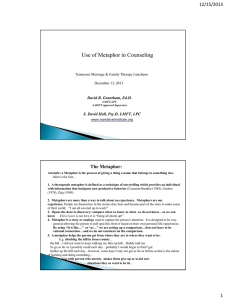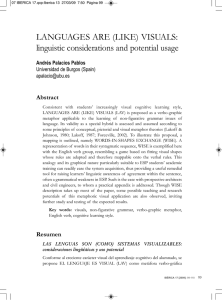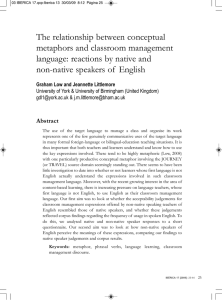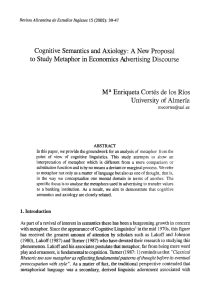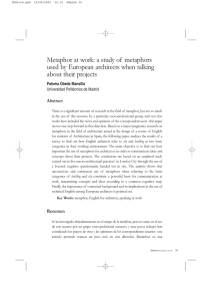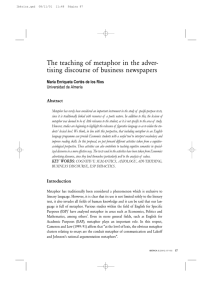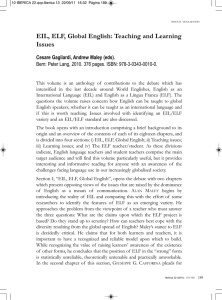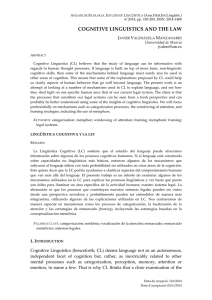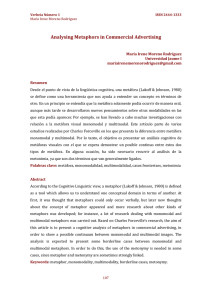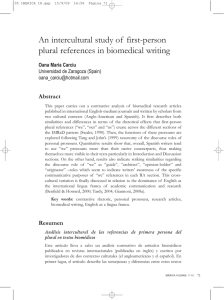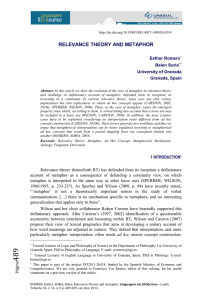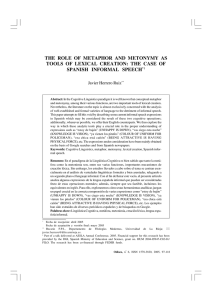The effect of context on the use of metaphor in discourse1
Anuncio
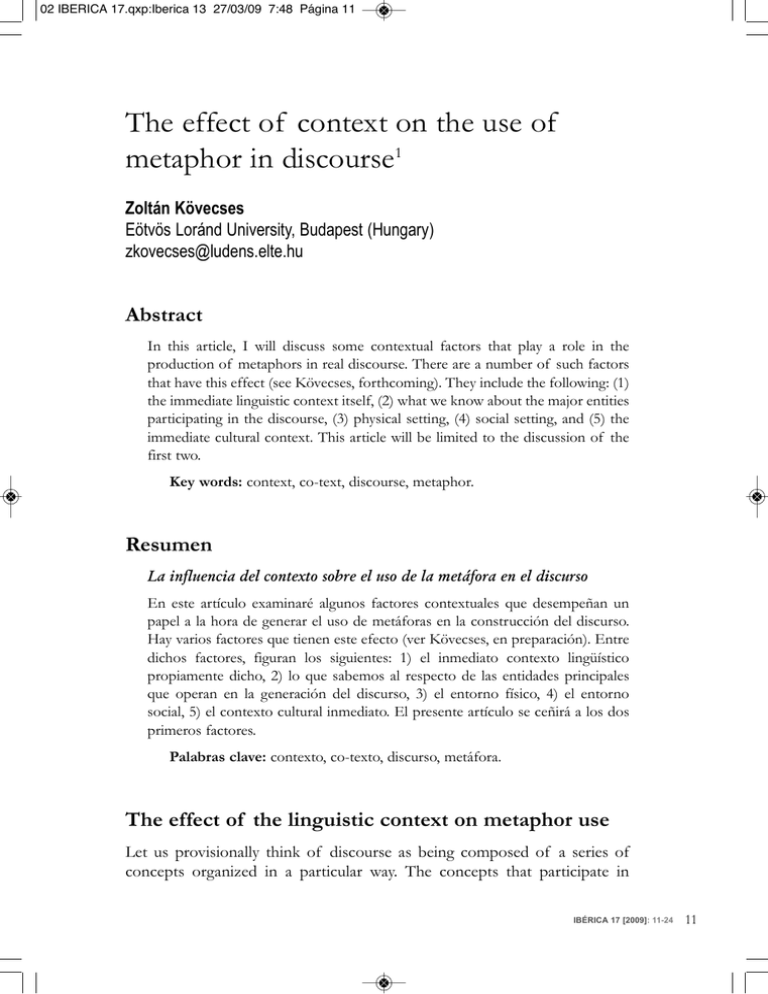
02 IBERICA 17.qxp:Iberica 13 27/03/09 7:48 Página 11 The effect of context on the use of metaphor in discourse1 Zoltán Kövecses Eötvös Loránd University, Budapest (Hungary) [email protected] Abstract In this article, I will discuss some contextual factors that play a role in the production of metaphors in real discourse. There are a number of such factors that have this effect (see Kövecses, forthcoming). They include the following: (1) the immediate linguistic context itself, (2) what we know about the major entities participating in the discourse, (3) physical setting, (4) social setting, and (5) the immediate cultural context. This article will be limited to the discussion of the first two. Key words: context, co-text, discourse, metaphor. Resumen La influencia del contexto sobre el uso de la metáfora en el discurso En este artículo examinaré algunos factores contextuales que desempeñan un papel a la hora de generar el uso de metáforas en la construcción del discurso. Hay varios factores que tienen este efecto (ver Kövecses, en preparación). Entre dichos factores, figuran los siguientes: 1) el inmediato contexto lingüístico propiamente dicho, 2) lo que sabemos al respecto de las entidades principales que operan en la generación del discurso, 3) el entorno físico, 4) el entorno social, 5) el contexto cultural inmediato. El presente artículo se ceñirá a los dos primeros factores. Palabras clave: contexto, co-texto, discurso, metáfora. The effect of the linguistic context on metaphor use Let us provisionally think of discourse as being composed of a series of concepts organized in a particular way. The concepts that participate in ibérica 17 [2009]: 11-24 11 02 IBERICA 17.qxp:Iberica 13 27/03/09 7:48 Página 12 ZoLTán KövEcSES discourse may give rise to either conventional or unconventional and novel linguistic metaphors. Suppose, for example, that we talk about the progress of a particular process and want to say that the progress has become more intense. There are many ways in which this can be done. We can say that the progress “accelerates”, “speeds up”, “gains momentum”, “moves faster”, “picks up” or “gathers speed”, and many others. These are all relatively “conventional” ways of talking about an increase in the intensity of a process. They are all based on the conventional generic-level mapping InTEnSITy IS SpEEd, as it applies to the concept of progress (in relation to a process). The larger metaphors within which the mapping InTEnSITy IS SpEEd works are also well established ones: progrESS IS moTIon forWard and, even more generally, EvEnTS arE movEmEnTS. However, the particular concepts that refer to the specific process we are talking about may influence the selection of the linguistic metaphorical expression in talking about the intensity of the progress at hand. The linguistic metaphors we actually use may be much “less conventional” than the ones mentioned above. as an example, consider a headline from The Wall Street Journal Europe (6 Jan. 2003). It reads (taken from Kövecses (2005) and reanalyzed here): The americanization of Japan’s car industry shifts into higher gear. Here, the process is the americanization of Japan’s car industry and the suggestion is that it has become, or is becoming, more intense. Instead of describing the property of “increase in intensity” by any of the conventional linguistic metaphors above, or, as a matter of fact, by a large number of additional ones that could be used (such as “galloping ahead”), the author uses the relatively unconventional linguistic metaphor “shifts into higher gear” (which is also an instance of the general metonymy acTIon for rESuLT, where shifting into higher gear results in higher speed, that is, we have SHIfTIng gEar for goIng faSTEr). Such headlines are also discussed by White and Herrera (2009). I propose that this particular expression is selected because of the influence of the immediate linguistic context, that is, the concepts that surround the conceptual slot where we need an expression to talk about “an increase in intensity” (of the progress of a process). Since the process is that of the americanization of Japan’s “car” industry, we find it natural and highly motivated that the author of the utterance uses the expression “shifts into 12 ibérica 17 [2009]: 11-24 02 IBERICA 17.qxp:Iberica 13 27/03/09 7:48 Página 13 THE EffEcT of conTExT higher gear” in that conceptual slot in the discourse. Since the surrounding context includes the car industry, it makes sense to use the motion of a car, and not the motion of some other entity capable of motion, in the metaphor. It seems to me that the pressure of coherence (i.e., trying to be coherent with the linguistic context) is at work here. Jean aitchison (1987) made an interesting observation that bears on this issue. She noted that in newspaper articles and headlines about (american) football games, the names of the teams may select particular metaphors for defeat and victory. She found such examples as follows in the sports pages of american newspapers: “cougars drown Beavers,” “cowboys corral Buffaloes,” “air force torpedoes the navy,” “clemson cooks rice” (aitchison, 1987: 143). metaphors used in these sentences are selected on the basis of the names of football teams. Since beavers live in water, defeat can be metaphorically viewed as drowning; since cowboys corral cattle, the opponent can be corralled; since navy ships can be torpedoed, the opponent can be torpedoed, too; and since rice can be cooked, the same process can be used to describe the defeat of the opponent. The metaphors in the above sentences indicate that the target domain of dEfEaT can be variously expressed as “drowning”, “corralling”, etc., the choice depending on the concepts (in this case, corresponding to the names of the teams) that make up the utterances in which the metaphor is embedded. defeating an opponent is a form of symbolic control, in the same way as the sports activities themselves are symbolic activities. In general, defeating an opponent is conceptualized as physically and/or socially controlling an entity (either animate or inanimate). The high-level, schematic conceptual metaphor dEfEaT IS pHySIcaL and/or SocIaL conTroL is pervasive in English (and also in other languages); metaphorical words for this conceptualization abound: “beat”, “upset”, “subdue”, “knock out”, “clobber”, “kill”, “demolish”, “conquer”, “crush”, “dash”, “destroy”, “dust”, “lick”, “overcome”, “overwhelm”, “ruin”, “stump”, “vanquish”, “thrash”, “trample”, “trounce”, and literally hundreds of others. The words all indicate some form of physical or social control. The words “cook” and “torpedo” from aitchison’s (1987) examples could be added to this list, although they seem to be somewhat “less conventional” than the others. Since defeat is conceptualized as physical and social control, it makes sense for the author to use the words “cook” and “torpedo” in the conceptual slot in the neighborhood of the concepts rIcE and navy, respectively. It makes sense because the frame for rIcE involves cooKIng and the ibérica 17 [2009]: 11-24 13 02 IBERICA 17.qxp:Iberica 13 27/03/09 7:48 Página 14 ZoLTán KövEcSES frame for navy can involve the weapon TorpEdo, on the one hand, and because cooKIng and TorpEdoIng are ways of physically controlling an entity, on the other. There is, however, more complication we need to be aware of. In the SporTS compETITIon frame, or more specifically, the amErIcan fooTBaLL frame, there are two opponents, there is an activity on the basis of which the winner is decided, and a resulting relationship between the two opponents: one opponent defeating the other. given these minimal elements in the frame, we can say that one team defeats another and we can choose a word from the list above to express this meaning. We do this on the basis of the metaphor dEfEaT IS pHySIcaL/SocIaL conTroL. However, how do the concepts of rIcE and navy that are used in the source domain of this metaphor end up in the amErIcan fooTBaLL frame? american football teams are not identical to rIcE and navy; these are concepts that we primarily associate with very different entities, such as plants and the armed forces, respectively. football teams are not plants and armed forces. obviously, they enter the frame because they are the names of the two football teams. They enter it on the basis of the metonymy namE for THE InSTITuTIon (i.e., namE of THE TEam for THE TEam). This metonymy is crucial in understanding the selection of the particular linguistic expressions for defeat. Without the metonymically introduced names for the teams, it would be much less likely for the author to use the terms “cook” and “torpedo”. The other two words in the set of examples offered by aitchison (1987), “corral” and “drown”, require similar treatment. We should note, however, that “corralling” and “drowning” are even less conventional cases of talking about defeat than “cook” and “torpedo” are. What nevertheless makes them perfectly understandable and natural in the context is that the frame for amErIcan fooTBaLL contains the names “cowboys” and “Beavers”. The words “corral” and “drown” are coherent with these names, on the one hand, and they also fit the dEfEaT IS pHySIcaL/SocIaL conTroL metaphor, on the other. In other words, there seem to be three constraints on the use of such metaphorical expressions in discourse. first, the words used must be consistent with an element of a conceptual frame that occurs in the discourse (such as those for dEfEaT or progrESS). This would simply ensure that we use literal or metaphorical linguistic expressions for 14 ibérica 17 [2009]: 11-24 02 IBERICA 17.qxp:Iberica 13 27/03/09 7:48 Página 15 THE EffEcT of conTExT dEfEaT or progrESS, and not for something else. Second, the linguistic metaphor must be consistent with a high-level, schematic metaphor conventionally used for that element, such as dEfEaT or progrESS). In the two cases above, they would be dEfEaT IS pHySIcaL/SocIaL conTroL and InTEnSITy of progrESS IS SpEEd. Third, the linguistic metaphors chosen on the basis of such metaphors should (probably “must” would be too strong a word here) be consistent with other more specific elements in the same frame (such as amErIcan fooTBaLL and the progrESS of a procESS). Such more specific elements within the amErIcan fooTBaLL frame would be the names of the teams and within the progrESS of a procESS the specific process in question (the americanization of Japan’s “car” industry). This is not to say that all uses of metaphorical expressions in discourse are motivated by such complex cognitive mechanisms. The linguistic context can play a somewhat more straightforward role in the selection of metaphors. consider the following text: When the Electoral commission came to make its choice between referring the case to the police and taking no action it was this defence, described by an authoritative source as showing “contempt” for the law, which helped to tilt the balance –and mr Hain– over the edge. (The Times, 25 Jan. 2008, news 7) The metaphorical expressions that are relevant here are “tilt the balance” and “[tilt] over the edge”. The second metaphorical expression is elliptical in the text, but we can easily supply the word “tilt” to make the sentence complete. Why can we do this? We can do it, of course, because the word “tilt” that was used in the first expression also fits the second. We keep it in memory and since it fits, we can supply it again. Let us look at some of the details of how this might happen. The metaphorical expression “tilt the balance” is a conventional one and is a linguistic example of the metaphor uncErTaInTy IS BaLancE (of THE ScaLES) (and cErTaInTy IS LacK of BaLancE of THE ScaLES). In the metaphor, making a choice (i.e., eliminating uncertainty) corresponds to tilting the balance. The second expression, “tilt someone over the edge”, is much less conventional than the first. The question is why the word “tilt” gets selected in the second one besides the fact that it is still in memory. clearly, it has to fit, but why does it fit? In the second expression the relevant conceptual metaphor is LoSS of raTIonaL/moraL ibérica 17 [2009]: 11-24 15 02 IBERICA 17.qxp:Iberica 13 27/03/09 7:48 Página 16 ZoLTán KövEcSES conTroL IS LoSS of pHySIcaL conTroL, such as pHySIcaL faLL (InTo a (dEEp) HoLE). The cause of the loss of rational/moral control is the same as the cause that made the commission arrive at a decision –namely, “showing ‘contempt’ for the law”. There are many linguistic expressions that could be used to convey the idea “to cause someone to fall down (into a hole)”, including “push”, “drive”, “force”, “jolt”, “nudge”, “poke”, “prod”, “propel”, “shove”, “press”, “butt”, and so on. of these, the most conventional ones are certainly “push” and “drive”; both of which occur in the idiom “push/drive someone over the edge”. However, in the discourse the author uses “tilt”, which is an additional but somewhat unmotivated possibility to express the idea of causing someone to physically fall down (into a hole). What makes it acceptable and natural, though, is that it fits the metaphor (no matter how unconventionally), on the one hand, and that it is elicited by the word used in the previous linguistic metaphor. In this manner, the phonetic shape of an expression in discourse can function as an elicitor of a metaphorically used expression in the same discourse, provided that the condition of fitting the required conceptual metaphor is also met. The effect of knowledge about major entities in the discourse on metaphor use In other cases, it seems to be our knowledge about the entities participating in the discourse that plays a role in choosing our metaphors in real discourse. major entities participating in discourse include the speaker (conceptualizer), the hearer (addressee/conceptualizer), and the entity or process we talk about (topic). I shall discuss three such examples, involving the topic, the speaker/conceptualizer, and the addressee/conceptualizer –in this order. Topic The Hungarian daily Magyar Nemzet (Hungarian nation) carried an article some years ago about some of the political leaders of neighboring countries who were at the time antagonistic to Hungary. one of them, the then Slovak president, meciar, used to be a boxer. This gave a Hungarian journalist a chance to use the following metaphor that is based on this particular property of the former Slovak president (Kövecses, 2005): 16 ibérica 17 [2009]: 11-24 02 IBERICA 17.qxp:Iberica 13 27/03/09 7:48 Página 17 THE EffEcT of conTExT a pozsonyi exbokszolóra akkor viszünk be atlanti pontot érő ütést, ha az ilyen helyzetekben megszokott nyugati módra “öklözünk”: megvető távolságot tartva. (Hungarian Nation, 13 Sep. 1997) We deal a blow worth an atlantic point to the ex-boxer of Bratislava if we box in a western style as customary in these circumstances: keeping an aloof distance. [my translation] confrontational international politics is commonly conceptualized as war, sports, games, etc. There are many different kinds of war, sports, and games, all of which could potentially be used to talk about confrontational international politics. In all probability, the journalist chose boxing because of his knowledge (shared by many of his readers) about one of the entities that constitute the topic of the discourse. In using the metaphor confronTaTIonaL InTErnaTIonaL poLITIcS IS BoxIng, the author is relying both on some conventional and unconventional mappings. What is common to the war, sports, and games metaphors is, of course, that they all focus on and highlight the notion of winning in relation to the activity to which they apply. This is their shared “meaning focus” (Kövecses, 2000 & 2002) and this is what makes up the conventional part of the metaphor. The boxer corresponding to the politician and the blows exchanged corresponding to the political statements made are explicitly present in the discourse in question. In addition, we also assume that both boxers want to win and that the participating politicians want the same (whatever winning means in politics). However, the manner in which the boxers box and politicians argue is not a part of the conventional framework of the metaphor. “Keeping an aloof distance” probably comes into the discourse as a result of the author thinking about the target domain of politics. In the author’s view, politics regarding meciar should be conducted in a cool, detached manner. What corresponds to this way of doing politics in boxing is that you box in a way that you keep an aloof distance from your opponent. In some cases the multi-faceted nature of the topic can be exploited by a speaker/conceptualizer for humorous effects, as in the following newspaper headline: “foot heads arms body.” We get an explanation of what this could possibly mean from the short letter sent in to the editor of The Times: Sir, The letters about odd headlines … reminded me of an all-time favourite. In the early 1980s michael foot became the leader of the Labour party. He ibérica 17 [2009]: 11-24 17 02 IBERICA 17.qxp:Iberica 13 27/03/09 7:48 Página 18 ZoLTán KövEcSES was also a co-founder of cnd and pushed for nuclear disarmament. mr foot travelled to Brussels to chair a lobby group in the European parliament to construct a plan to get rid of the bomb as part of the European election policy. from this came the headline “foot heads arms body”. (The Times, Letters to the Editor, 30 Jan. 2008) Since the topic involves the various entities, such as foot and disarmament and mr. foot being the chair of the committee that deals with the issue of disarmament, the speaker/conceptualizer had the opportunity to deliberately create a humorous headline. Speaker In the previous cases, the metaphor was selected and elaborated as a result of what the conceptualizer knows about the topic. It is also possible to find cases where the selection of a metaphor depends on knowledge about the conceptualizer himself or herself. What is especially intriguing about such cases is that the author’s (conceptualizer’s) knowledge about him- or herself does not need to be conscious. The next example, taken from my previous work (Kövecses, 2005) but reanalyzed here, demonstrates this possibility. as one would expect, one important source of such cases is the area of therapy or psychological counseling. In a therapeutic context people commonly create novel metaphors as a result of unique and traumatic life experiences. The metaphors that are created under these circumstances need not be consciously formed. The example comes from an article in the magazine A & U (march, 2003) about photographic artist frank Jump. frank Jump photographs old painted mural advertisements in new york city. He has aIdS, but he has outlived his expected life span. His life and his art are intimately connected metaphorically. The conceptual metaphor operative here could be put as follows: SurvIvIng aIdS dESpITE prEdIcTIonS To THE conTrary IS for THE oLd muraL advErTISEmEnTS To SurvIvE THEIr ExpEcTEd “LIfE Span.” at first, Jump was not consciously aware that he works within the frame of a conceptual metaphor that relies on his condition. In his own words: In the beginning, I didn’t make the connection between the subject matter and my own sero-positivity. I was asked to be part of the day Without art exhibition a few years ago and didn’t think I was worthy –other artists’ work was much more HIv-specific. (…) But my mentor said, “don’t you see the 18 ibérica 17 [2009]: 11-24 02 IBERICA 17.qxp:Iberica 13 27/03/09 7:48 Página 19 THE EffEcT of conTExT connection? you’re documenting something that was never intended to live this long. You never intended to live this long.” [italics in the original] (A & U, march 2003: 27) The mentor made the conceptual metaphor conscious for the artist. I believe something similar is happening in many cases of psychotherapy and counseling. It is clear that the metaphor SurvIvIng aIdS dESpITE prEdIcTIonS To THE conTrary IS for THE oLd muraL advErTISEmEnTS To SurvIvE THEIr ExpEcTEd “LIfE Span” is anything but a conventional conceptual metaphor. The metaphor is created by frank Jump as a novel analogy –the unconscious but nevertheless real analogy between surviving one’s expected life span as a person who has aIdS and the survival of the mural advertisements that were created to be around on the walls of buildings in new york city for only a limited amount of time. In this case, (unconscious) self-knowledge leads the conceptualizer to find the appropriate analogy. The analogy is appropriate because the source and the target domains share schematic structural resemblance; namely, an entity existing longer than expected. The resulting metaphor(ical analogy) is novel and creative and it comes about as a result of what the conceptualizer knows about himself. Topic and hearer Let us take another example of how the topic can influence the choice of novel metaphors in discourse. as we shall see, the example is additionally interesting because it gives us some idea how the addressee may also be involved in the selection of metaphors by the speaker/conceptualizer. In the comment section of The Times (30 Jan. 2008), the author congratulates and offers advice to the newly elected head coach of the England football team. His or her specific recommendation is that fabio capello, the new Italian head coach, should play david Beckham against Switzerland in an upcoming game at Wembley Stadium, despite the fact that Beckham did not play top-class football for several months at the time. If Beckham is given a chance to play, he will have played on the English national team 100 times, and this would be a nice way of saying good-bye to him as regards his career on the national team. The author of the article explains that he or she is aware that Beckham is not fully prepared for this last game on the national team. S/he writes: ibérica 17 [2009]: 11-24 19 02 IBERICA 17.qxp:Iberica 13 27/03/09 7:48 Página 20 ZoLTán KövEcSES Beckham is 32. He has not played top-class football since november. Los angeles galaxy are sardines not sharks in the ocean of footy. (The Times, 30 Jan. 2008: 14) How did the author arrive at the novel metaphors according to which the american football (soccer) team, the Los angeles galaxy, “are sardines not sharks in the ocean of footy”? In all probability, it is the author’s knowledge about david Beckham, the main topic of the discourse, that gives rise to the metaphors. The author (together with us) knows that Beckham plays for the Los angeles galaxy, a team located in Los angeles, which, in turn, is a city on the pacific ocean, and the pacific ocean contains sardines and sharks. In somewhat more technical language, we could say that the frame for Beckham as a football player includes the name of the team that he plays for and the place where the team is located, which in turn evokes the frame of the pacific ocean. The frame for the pacific ocean in turn involves the various kinds of fish that live in that ocean. of all these various kinds of fish, why are the Los angeles galaxy sardines and not sharks and why is football an ocean? With this question, I wish to indicate that the author’s knowledge about Beckham does not provide a full explanation of the novel metaphors used. It is a major part of the story, but probably not the whole story. What we have to take into account additionally are some highly schematic conventional conceptual metaphors, such as THE SIZE of SocIaL groupS IS THE SIZE of pHySIcaL EnTITIES and SocIaL compETITIon IS THE SurvIvaL BEHavIor of anImaLS. The former conceptual metaphor is extremely general and probably functions only as a very general constraint on which linguistic expression can actually be selected; the idea of the vastness of the world of football and the many teams participating in it should be conveyed through reference to some huge physical entity (such as the ocean). The latter conceptual metaphor seems to be a special case of the SocIaL BEHavIor IS anImaL BEHavIor metaphor. In the world of business competition, English has the conventional metaphorical expression: “big fish eat small fish”. Similarly, in football some teams are very powerful (the sharks), but most of them are weak (the sardines) in relation to the powerful ones. The expression “big fish eat small fish” and the underlying conceptual metaphor may in part be responsible for the author using the words “sardines” and “sharks” for some of the strong teams and for the much larger number of weak teams in the world of football. 20 ibérica 17 [2009]: 11-24 02 IBERICA 17.qxp:Iberica 13 27/03/09 7:48 Página 21 THE EffEcT of conTExT The same article also offers us a glimpse of how knowledge about the addressee can give rise to novel metaphors in discourse. There are two examples in the article that point in that direction. The first one reads: “dear Signor capello” [my italics]. This is the first sentence of the article, with which the author addresses the intended recipient of the message – the new Italian head coach of the English team, fabio capello. although the use of the word Signor could not be interpreted as a metaphor, the fact that the English author addresses the recipient (Signor capello), an Italian, partly in Italian is an indication that, in general, the addressee plays a role in how we select linguistic items for our particular purposes in the discourse. The second example is as follows: “Beckham is a good footballer and a nice man: e una bella figura” [italics in the original]. This example comes much closer to being a metaphor, in that a man (Beckham) is compared to a figure, a shape –a schematic word for geometric forms. In addition, the comparison is given in Italian, which shows that the language of the addressee must have influenced the choice of the metaphor. more generally, a part of what we know about the addressee in all probability plays a role in the selection of the metaphor. Personal concern as a special case a further factor that plays a role in producing differential experience and, hence, differential metaphors, includes the differential concerns, or interests, that speakers/conceptualizers may have in their lives. We can think of such differential personal concerns as a special case of the knowledge that speakers/conceptualizers have of themselves. Let us look at how this can influence our choice of metaphor in discourse. Intense professional interest may lead a person to habitually think about and express target domains in terms of source domains that are based on one’s professional interests. a good way of studying this form of variation is to look at letters in newspapers that are sent in to editors by readers. In Hungarian newspapers the authors of the letters often mention their profession. consider the following letter by a Hungarian electric engineer concerning the issue of Hungary’s new relationship with Europe in the late 1990s (taken from Kövecses, 2005): Otthon vagyunk, otthon lehetünk Európában. Szent István óta bekapcsolódtunk ebbe a szellemi áramkörbe, és változó intenzitással, de azóta benne vagyunk – akkor is, ha különféle erők időnként, hosszabbibérica 17 [2009]: 11-24 21 02 IBERICA 17.qxp:Iberica 13 27/03/09 7:48 Página 22 ZoLTán KövEcSES rövidebb ideig, megpróbáltak kirángatni belőle. [italics in the original] (Magyar Nemzet, [Hungarian Nation] 12 June 1999) We are, we can be at home in Europe. Since Saint Stephen we have been integrated/connected to this intellectual/spiritual electric circuit, and with varying degrees of intensity, but we have been in it –even though various powers, for more or less time, have tried to yank us out of it. [my translation] The target domain is Hungary’s new relationship to Europe in the wake of major political changes in the country in the 1990s. The interesting question is what the source domain is. as the passage makes it clear, many of the words used reflect the professional interest of the author of the letter: “be integrated/connected”, “electric circuit”, “with varying degrees of intensity” are expressions that reveal electricity and electric circuitry as a source domain in the passage. The electric engineer reasons on the basis of his knowledge of this domain. The concept of electricity and electric circuitry as a source domain is not obvious or inevitable for this target and is certainly not the only one that could be used. my claim is that it is made available and its use is facilitated by the professional interest of the person who does the thinking about this particular target domain. doctors, teachers, athletes, scientists, and so on, often take their source domains from their fields of activity to characterize and reason about the various target domains they encounter, talk, and think about. Conclusion In this paper, I have discussed some contextual factors that appear to have an effect on the production of metaphors in real discourse. We can think of such cases as instances of metaphorical creativity, which can be called “context-induced” creativity. To the best of my knowledge, apart from some sporadic instances (such as aitchison, 1987; Koller, 2004; Kövecses, 2005 & 2006; Semino, 2008; Benczes, forthcoming), the issue of context-induced metaphorical creativity has not been systematically investigated. a considerable portion of novel metaphorical language seems to derive from such contextual factors as the immediate linguistic context and knowledge about major discourse participants, as demonstrated in the paper. It remains to be seen how robust the phenomenon is and whether it deserves serious further investigation. Based on an informal collection of data from a variety of newspapers, it appears that the context provides a major source of 22 ibérica 17 [2009]: 11-24 02 IBERICA 17.qxp:Iberica 13 27/03/09 7:48 Página 23 THE EffEcT of conTExT motivation for the use of many novel metaphors. These metaphors are clearly not, in grady’s (1999) classification, either resemblance or correlation-based cases. They seem to have a unique status, in that they are grounded in the context in which metaphorical conceptualization is taking place. (Revised paper received October 2008) References Aitchison, J. (1987). Words in the Mind. Oxford: Blackwell. Benczes, R. (forthcoming). “Setting limits on creativity in the production and use of metaphorical and metonymical compounds” in S. Michel & A. Onysko (eds.), Cognitive Approaches to Word Formation. New York: Mouton de Gruyter. Grady, J. (1999). “A typology of motivation for conceptual metaphors. Correlations vs. resemblance” in R.W. Gibbs & G.J. Steen (eds.), Metaphor in Cognitive Linguistics, 79-100. Amsterdam: John Benjamins. Koller, V. (2004). Metaphor and Gender in Business Media Discourse: a Critical Cognitive Study. New York: Palgrave Macmillan. Kövecses, Z. (2000). Metaphor and Emotion. New York: Cambridge University Press. Kövecses, Z. (2002). Metaphor. A Practical Introduction. New York: Oxford University Press. Kövecses, Z. (2005). Metaphor in Culture. Universality and Variation. New York: Cambridge University Press. Kövecses, Z. (2006). Language, Mind, and Culture. A Practical Introduction. New York: Oxford University Press. Kövecses, Z. (forthcoming). Metaphor. A Practical Introduction. 2nd edition. New York: Oxford University Press. Semino, E. (2008). Metaphor in Discourse. Cambridge: Cambridge University Press. White, M. & H. Herrera (2009). “How business press headlines get their message across: A different perspective on metaphor” in J. Zinken & A. Musolff (eds.), Metaphor and Discourse, 135152. New York: Palgrave Macmillan. Zoltán Kövecses is professor of Linguistics at Eötvös Loránd university, Budapest and has been visiting professor at many European and american universities. He is a leading figure in cognitive Linguistics with numerous articles and a dozen books to his name, including Metaphor. A Practical Introduction (oxford university press, 2002), the second edition of which is about to appear. NOTES 1 research for this paper was generously supported by the Institute of advanced Study, durham university, England, where I was a distinguished fellow in the winter term, 2008. ibérica 17 [2009]: 11-24 23
